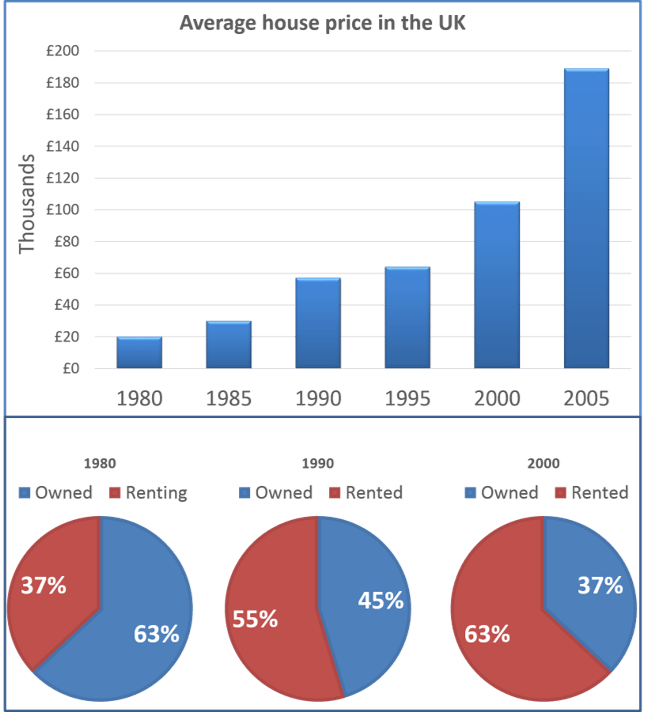Task 1
You should spend about 20 minutes on this task.
The bar chart shows the average price of a house in the UK in different years. The pie charts show the percentage between homeowners and those who are renting.

Summarise the information by selecting and reporting the main features, and make comparisons where relevant.
Write at least 150 words.
The illustrations given relate to housing costs and accommodation status in Britain. The bar chart has a 25 year range in 5 yearly increments from 1980; the pie charts cover 3 different years from 1980, divided into 10 year periods.
The most striking feature of the bar chart is that the median cost for housing increased more than seven fold over the period given, from approximately £20,000 to just under £200,000. The most dramatic increases were between 1985 and 1990, and again from 2000 to 2005. In both time periods, the cost of housing almost doubled.
As house prices increased, it is notable that the percentage of home ownership declined, falling from 63% down to 37% by 2000. Inevitably, this presented an inverse correlation with properties that were rented, to the point where the situation in 2000 was the mirror opposite of tenancy status when compared to 1980. In 1990, the comparison between ownership and rental was close, with only a 10 percent difference.
Overall, it is evident that increasing house costs where matched with increasing rental of homes.
(180 words)
Task 2
You should spend about 40 minutes on this task.
Write about the following topic:
An increasing number of larger shopping areas, malls and department stores are leading to the decline of smaller corner shops.
What are the advantages and disadvantages of shopping in larger shopping centres rather than smaller, more traditional shops?
Give reasons for your answer and include any relevant examples from your own knowledge or experience.
You should write at least 250 words.
There are a number of factors that have led to a marked increase in the number of large scale shopping areas and a subsequent decline in the number of smaller, local shops. Although there are advantages for the consumer, there are also a number of disadvantages, as will now be discussed.
One of the main advantages is related to the amount of stock that larger retail parks can support; smaller shops may stock only one or two brands of a particular item, whereas department stores and the like may have a multitude of options. Pricing is also an issue in which the larger stores tend to have an advantage as they can afford to sell items to consumers at prices the smaller shops cannot match.
However, there are some significant disadvantages to larger shopping areas, the main issue being a loss of the more traditional ‘customer oriented’ service. Smaller local shops often become part of the community, where the shopkeeper know the customers by name and can build relationships that are absent in the larger, more impersonal stores. Customer satisfaction is arguably far more of a priority in the smaller shops and there is a sense of contributing to the local community.
Another disadvantage that does not directly relate to the customer or the shopkeeper is that the larger retail parks and department stores are rarely close, meaning that people visiting these areas are often required to travel by car, thus contributing to pollution levels.
To sum up, although there are some material advantages to large shopping complexes, these are perhaps outweighed by the social and environmental advantages of patronising smaller, local shops.
(273 words)
